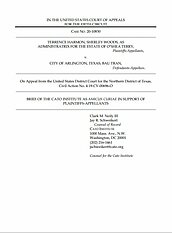Learn more about Cato’s Amicus Briefs Program.
In September 2018, a Texas police officer pulled over O’Shae Terry for an expired registration tag. After approaching Terry’s side of the vehicle, the officer smelled marijuana, and went back to her patrol car, leaving Terry and his passenger, Terrence Harmon, with officer Bau Tran. After a few minutes, Terry decided to end the traffic stop and started to roll up his windows. In response, Tran grabbed onto the passenger side window and climbed onto the vehicle’s running board as he reached into the vehicle. Immediately after, Tran withdrew his hand and reached for his service weapon. Two seconds after Terry started the engine, and one second after Terry took his foot off the brake to pull away, Tran shot Terry. Harmon had to remove his dying friend’s leg from the gas pedal and apply the brake with his hands, and Terry later died at the hospital.
The shooting of O’Shae Terry sparked protests in North Texas, and – unlike in the cases of many other shootings of unarmed black men by police officers – Bau Tran was criminally charged with negligent homicide (that charge is still pending). But when O’Shae Terry’s family brought a civil rights claim against Tran, their complaint was dismissed on the basis of qualified immunity. In the Fifth Circuit, “[i]t has long been clearly established that, absent any other justification for the use of force, it is unreasonable for a police officer to use deadly force against a fleeing felon who does not pose a sufficient threat of harm to the officer or others.” Lytle v. Bexar Cty., 560 F.3d 404, 417 (5th Cir. 2009). In this case, O’Shae Terry was not even a suspected felon, and there was no threat to the public or other officers – Terry was simply beginning to drive away, which was enough for Tran to shoot and kill him. Nevertheless, the district court granted qualified immunity to Tran, simply because there was no prior case involving the exact factual scenario presented here, where an officer “is on the side of a vehicle while the driver is driving away in blatant disregard of his instructions.”
Cato has therefore filed an amicus brief in support of the Terry family’s appeal to the Fifth Circuit. The brief argues that the district court fundamentally misunderstood and misapplied the “clearly established law” standard, conflating the requirement that clearly established law be “particularized” to the facts of a case with a non-existent requirement that prior case law involve identical facts as the present case. This distinction is reinforced by the Supreme Court’s recent decision in Taylor v. Riojas, in which the Court summarily reversed a Fifth Circuit panel that had granted qualified immunity to corrections officers who held a man in utterly inhumane conditions for six days. The Court said that, even though there was no prior case where an inmate was kept in such deplorable conditions for “only” six days, any reasonable person in the defendants’ position would have known that treatment was unconstitutional. Just so here. Fourth Amendment law in the Fifth Circuit (and elsewhere) made clear that it was unlawful to use deadly force against a fleeing suspect who posed no threat to anyone. Any reasonable officer in Tran’s position would have known that shooting O’Shae Terry was unreasonable, whether or not a prior case specifically involved an officer “on the side of a vehicle while the driver is driving away in blatant disregard of his instructions.”
Our brief also argues, as we have argued many times before, that qualified immunity itself is fundamentally unlawful, as it is unsupported by the text or history of the statute it is supposed to be interpreting. The Fifth Circuit obviously has to apply Supreme Court precedent on qualified immunity, whether or not that precedent is well reasoned. But the fact that qualified immunity itself has such shaky legal foundations should make lower courts especially vigilant to avoid unwarranted expansions of the doctrine.

This work is licensed under a Creative Commons Attribution-NonCommercial-ShareAlike 4.0 International License.



